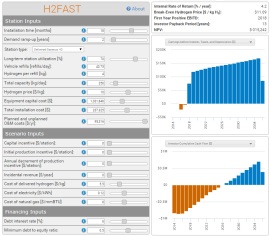by Brianna Crandall — June 3, 2015—Facilities owners and managers who have an on-site hydrogen refueling station or are considering the addition of a station to their facilities may benefit from two new tools, a guide and two reports recently launched by the U.S. Department of Energy (DOE) that were developed through public-private partnership H2USA to support hydrogen fueling infrastructure deployment.
The two new tools were developed by the Energy Department’s National Renewable Energy Laboratory (NREL) and Argonne National Laboratory respectively to address the key technical and financial barriers to hydrogen fueling infrastructure deployment.
 H2FAST provides in-depth financial analysis including cash flow and return on investment for hydrogen fueling stations based on key financial inputs such as station capital cost, operating cost, and financing mechanisms.
H2FAST provides in-depth financial analysis including cash flow and return on investment for hydrogen fueling stations based on key financial inputs such as station capital cost, operating cost, and financing mechanisms.(Click on image to enlarge)
The Hydrogen Financial Analysis Scenario Tool (H2FAST) provides in-depth financial analysis including cash flow and return on investment for hydrogen fueling stations based on key financial inputs such as station capital cost, operating cost, and financing mechanisms.
The online format lets the user vary approximately 20 station installation and financial inputs to see how the basic financial performance metrics change. The spreadsheet version provides the user with detailed annual finance projections, financial performance parameters, and other results for single stations or groups of up to 10 stations.
H2FAST was developed to complement the Hydrogen Refueling Station Analysis Model (HRSAM), which assesses the impact of station design on the economics and incorporates a station’s capital and operating cost based on key design variables such as station capacity and mode of hydrogen delivery.
While safety requirements for industrial uses of hydrogen are relatively well established, placing hydrogen at public fueling stations and using it in vehicles have created the need for additional safety requirements. The new Hydrogen Technologies Safety Guide provides project developers, code officials, and others with background information that puts hydrogen safety in context, including the industrial history of hydrogen, basic safety concerns and safety requirements.
NREL and Sandia National Laboratories (SNL) published the two new reports through their joint Hydrogen Fueling Infrastructure Research and Station Technology (H2FIRST) project, which supports H2USA by addressing critical research and development (R&D) barriers to station deployment.
The H2FIRST Reference Station Design Task report details engineering designs and economic analyses of five hydrogen refueling station designs that can meet near-term market needs. The authors evaluated station economics using HRSAM and then prepared detailed designs that include piping and instrumentation diagrams and bills of materials. These reference designs are meant to help stakeholders evaluate station configurations and to encourage standardization of station components.
The H2FIRST Hydrogen Contaminant Detector Task report describes the current commercial state of the art in contamination detection and identifies the technical requirements for implementing a hydrogen contaminant detection device at a station.
As states with zero-emission vehicle programs prepare for commercial deployment of fuel cell electric vehicles, these tools and reports will support investors, regulatory bodies, and engineering design firms in developing cost-effective fueling infrastructure, says DOE.
DOE’s “Energy 101: Fuel Cell Technology” video on YouTube explains how fuel cells work.




